|
FAQs on Crustacean Parasites,
Diseases
Related Articles:
Crustacean Parasitic
Disease,
Isopod Crustaceans,
Marine Parasitic
Disease, Parasitic Worms,
Roundworms,
Related FAQs:
Copepods,
Isopods, Parasitic Disease 1, Parasitic Disease 2, Parasitic Disease 3, Parasitic Disease 4, Parasitic Disease 5, Parasitic Disease 6, Parasitic Disease 7, Parasitic Marine Tanks, Parasitic Reef Tanks,
Cryptocaryoniasis, Marine
Ich, Marine Velvet
Disease
Biological Cleaners, Fish Worm
Diseases 1, Treating
Parasitic Disease, Using
Hyposalinity to Treat Parasitic Disease, Roundworms, Tang
Health/Disease,
|
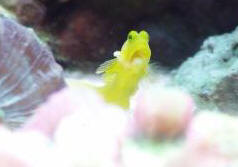
"The horror, the horror!"
|
|
Identify parasite
1/26/15
Hi crew!
I'm in need of professional advice identifying something that has been
attached to my clownfish. A little background: this was attached
to a clownfish that I've had since August. All of my fish go
through a quarantine protocol of tank transfer, followed by a treatment
of PraziPro
<Only useful for worms>
then followed by a month of observation in a cycled quarantine tank. All
inverts (and anything else wet) goes through 11 weeks in a cycled
quarantine tank (not the same as the fish). My reef tank has been
running for 10 years.
None of my fish are exhibiting symptoms of any parasites, no heavy
breathing, no flashing, piping, appetite is excellent, etc. As a matter
of fact my clown fish laid eggs the other day but I saw this thing on
her that looks like a skin tag. I did a FW dip in her
but it did not come off. I ended up putting her on a dissection tray and
pulling the thing off with a pair of tweezers. I took pictures of it on
my microscope. The Mag was 4x. It appears whatever it
is was killed by the FW dip but I am not able to identify what it is. It
doesn't appear to be a fluke, maybe some kind of isopod or
amphipod?
<I do think the former... IS a crustacean... appears to have legs that
are "all about the same" ('iso')... Do see WWM re these not-fun
rolly pollies... and their control. Likely your physical removal is the
end of them here>
Any help would be very appreciated. Thank you. Jennifer
<Do you need help using the indices, search tool? Bob Fenner> |
.jpeg)
.jpeg) |
|
Re: Identify parasite
1/27/15
Bob,
Yes, I do know how to use a search engine. The attached object looked
nothing like the images on that page. The one on my fish was clear, no eyes,
or even discernible legs.
<I see the eye, remnants of legs and even eggs here>
It actually looked like a skin tag or a raised scale.
Jennifer
<Could be something else; but my guess is still on an Isopod. BobF> |
|
Helfrichi Firefish Ectoparasite
11/20/14
Dear Wet Web Media Crew,
I am writing to ask for help on ID for an ectoparasite that showed up on
one of my Helfrichi Firefish about two weeks from purchasing them.
<I see this in your pic... some sort of crustacean... perhaps an Isopod>
The parasite looks like a pear shaped convex transparent disc that is
attached in only one point (the mouth, I assume). Motion wise, it can
move on the skin and leaves behind some skin abrasion / superficial
ulceration
that heals in a matter of days. I've also noted looking from profile
that the parasite undulates it's body continuously. The fish didn't look
bothered by the parasite and didn't try to scrape it off.
<For whatever reasons fish hosts don't seem to do that... does seem
strange>
As one of the two parasites was located on the head between the eyes,
quite close to the brain, I've decided to be proactive in removing them
and ask the questions later. The second parasite was attached on one
side of the
fish.
First step was to remove the fish. I've removed one third of the water
to reduce the chance of jumping out of the tank. Then after placing the
net in the tank, I've suddenly turned off the lights and the fish was in
seconds
in the net.
I've placed the fish in a container with one inch deep tank water and
I've covered it with glass and placed an LED light on top to allow me
good observation. First I've tried to remove the parasites with fine
tweezers.
The fish stayed still and let me try, but it was still impossible. As
the parasite didn't show any intention in letting go, I decided to quit
trying physical removal and to go for a chemical approach.
<For browsers and possible future events, I'd suggest using a
relaxant... a more concentrated solution of MgSO4, magnesium sulfate...
poured via a dropper over the parasite/s... ahead of trying removal>
This was done with Cupramine
<Mmm; there are other, better choices... that are less toxic to the fish
host, any other life (than arthropod) present. See here:
http://wetwebmedia.com/crustdisfaqs1.htm
that I placed in drops, undiluted on the parasite. After this, I
syringed water on the skin and the parasites finally dropped. I caught
the fish and placed back in the tank. The water in recipient was light
blue, I think I've used about 2 ml.s of undiluted Cupramine in 1L of
water.
<Yikes; this is a bunch of Cu>
The fish was in the water after adding the copper for maximum one
minute.
I didn't notice this parasite on any other Firefish (I have a trio), nor
any other fish (only watchman gobies and a Atrosalarias blenny). The
wounds on the affected fish healed in a matter of days and the fish
didn't show any signs of distress.
<Ah, good>
I need to know if there is a Helfrichi Firefish species specific
ectoparasite that fits the description.
<None that I'm aware of, no. Fish crustacean parasites (unlike various
worm groups) tend to be more generalized in host preferences>
And more generally, if you've got the knowledge of a ectoparasite as the
above as I need to figure out if there is a possibility of further
issues with this parasite in the tank (eggs, larvae etc.).
<Mmm; well; there don't appear to be any egg-sacs on the one... So am
hopeful there are not intermediate forms in your system. I would not...
oh I see you mention below>
The tank is FOWLR, with only a gorgonian frag that can be removed, the
only sensitive invertebrate difficult to catch being a pistol shrimp
highly guarded by four watchman gobies (A. latifasciata and S. yasha).
My ID would be either a flatworm (fits the shape, color, movement) or a
crustacean parasite (fish flea, isopod etc.).
I am attaching a photo of the parasite and the links to four movies
(full HD, zoomed, from close distance) with the parasites attached on
the fish before removal (please excuse the quality).
https://www.youtube.com/watch?v=qT34itquR4s with the fish in the tank
(the parasite on the head is quite visible in this video)
https://www.youtube.com/watch?v=Ngk1UkOXUvM
https://www.youtube.com/watch?v=tzUN0-2l0VA
https://www.youtube.com/watch?v=flMeaxiXd0Q
<Very nice>
Please feel free to use any part of the images/ videos if you find them
useful for other hobbyists. I am happy to provide the originals if
needed.
Thank you in advance for your patience and help!
Kind regards, Andrei C.
<And you for sharing. You have provided much useful information for
others use and further investigation. Bob Fenner>
|
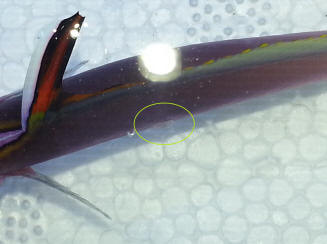
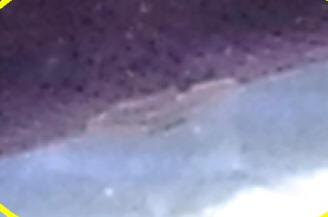 crop
crop |
|
Re: Helfrichi Firefish Ectoparasite
11/27/14
Good morning and thank you for your answer,
<Welcome>
As a follow up, the ectoparasite came back. I can now see it on all
three Firefish, one having a high number of parasites. They seem more
shy and now they hide at night time. Also, they've started scratching
against sand. It still seems they are the only affected fish in the
tank.
I intend to try and catch all three fish and treat in a separate tank. I
need you advice on the medication you think will help me kill the
parasite, as physical removal is technically impossible.
<I would use an arthrocide... an acetlycholinesterase inhibitor. Please
read here re:
http://wetwebmedia.com/isopodcontr.htm and
http://wetwebmedia.com/crustdisfaqs1.htm
My best bet is still Cupramine in therapeutic doses for a short period
(2-3 days), but I would love to use something more fish friendly.
<Do read the above>
Thank you in advance for your advice!
Kind regards, Andrei
<Again; glad to share. Bob Fenner>
|
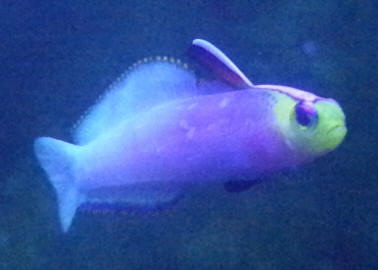 |
|
|
Howdy and thanks for sharing
3/27/14
Hi Bob,
<Hey Bri!>
Not sure if you remember me, we met at the New England fish disease
symposium. I kept telling you you look like bill Murray.
<Oh yes; certainly...>
I still work at A&M aquatics, and have attached a couple of pictures of
a parasite from a green Chromis and dispar Anthias. Just started seeing
them the past couple of months.
ID?
Hope all is well and warmer than Michigan,
Brianne
<Is this a copepod? Oh! Am in Cozumel diving w/ my sis... and met quite
a few folks from there... -30 degrees last week!? Join us! BobF>
|
.jpg)
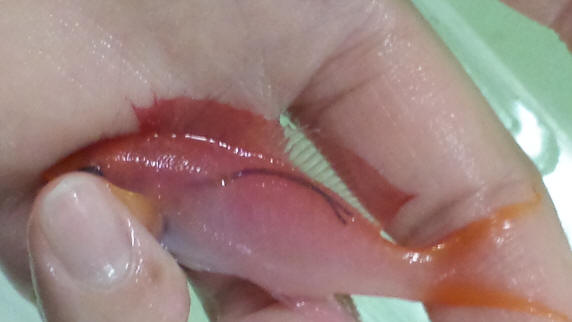 |
Parasite ID 5/21/13
Good evening WWM crew,
<Brielle>
My hippo tang, flame angelfish, and clownfish may be infected <infested>
with a parasite that I'm having trouble identifying. I have only seen it
a few times on them, but they yawn a lot which leads me to believe it is
mostly in their gills. It is about the length of lead in a
mechanical pencil (a little smaller actually). I can just
barely see it, but I can tell that it is long and narrow, not
round. It does not move once attached until a few days later when it
disappears. The fish lose a scale or two (turns whitish/clear
and falls off) every few days. They have had this condition for a few
weeks and the severity is not progressing quickly, so I don't think it
is Ich. Any thoughts?
<Mmm, this may (just) be body mucus... some sort of irritation (many
possibilities)... causing the fishes to exude>
Might parasitic copepods be this small?
<Can be; yes... but are not oblong, worm-like, unless the host is very
large (bill fish, whales)>
I have tried treating with Chloroquine phosphate and Praziquantel to no
effect.
<Again; I'd do what you can to spiff up water quality here; see WWM...
water changes, chemical filtrants, RedOx improvement... Unless you get
samples, look under a microscope, I would NOT randomly medicate>
I'd rather not use copper in my tank. Do you think parinox will help?
Thank you for your advice!
Brielle
<Welcome. Bob Fenner>
|
Puffer parasite?? 12/7/12
We have a new golden puffer for about 4 months now with no issues..
All of the sudden tonight when we went to feed them he had these rice like
"parasites" all over his body and one of his eyes.
None of the other fish in the tank have any signs of this and he is acting
normal so far.
Any ideas?
<Have tried enlarging some of these "zots" and enhancing the image... They
look like congealed spots of body mucus more than anything discrete; not
like a live organism. Tetraodonts are quite slimy and often particulates
will adhere to them... I'd review what your water quality, any supplements,
treatments you've added to the water... and not treat this fish/system in
any way. Bob Fenner>
|
[1]%20(1).jpg)
[1]%20(2).jpg)
|
Can pods attach to saltwater fish?
11/19/12
Hello WMV Crew,
<Jae>
I have an Allardi clownfish and a Neon Goby in my 26 gallon tank which
is crawling with tons of pods. My allardi usually sleeps attached to one
of the walls and facing upwards, while my neon goby is always seen
either on the back wall of the tank or live rock. The weird thing is,
from time to time, little white dots can be seen on both allardi and
goby. At first I thought they were Ich, but numerous times I've seen
allardi shaking the dots off himself, and then I can see the dots
swimming in the water afterwards!
<Not Crypt>
I don't think fish can just "shake off" Ich parasites,
<No; cannot>
so I'm guessing these white stuff are pods that attached to my allardi and
goby when they were sleeping. Can pods really attach to fish? Thanks!
-Jae
<Mmm, some can indeed. In fact, the group (Copepoda) has such diversity
as to span virtually all nutrition types... There are some quite
large/prominent truly parasitic species, many free-living, and some that
can/do "cross the line" to chew on fishes, other life when they can. Not
generally an issue as long as the fish livestock is healthy. Bob Fenner>
|
Help with parasite ID 3/17/12
Hi,
<Mark>
My Hawkfish recently picked up an unwelcome visitor.
It is a very small, about half the length of a grain of rice.
It is brownish, slightly transparent. The attachment point is
larger and more solid. It is soft, and flops around in the
current, so a bit worm like. It is not like a pill bug, so
probably not an isopod.
After reading various WetWebMedia pages, my thought is
some sort of parasitic copepod. But I could not
find any matching pictures.
Do you have any thoughts?
Picture enclosed.
<I do agree...>
The fish was in the display tank, but it has been removed to a
hospital tank. I have tried a Formalin dip with no luck. I will
likely try a freshwater dip next.
<Hold this fish in a soft net, with your and underneath, and
pull this crustacean out by grasping its anterior end with
tweezers near its insertion in the fish, and pulling backward
(toward the tail)>
In particular, a key question is if this is a sign of an
infestation and if I should be worried about my other fish?
<Likely this parasite has a complex life cycle and with the
removal of the one, this cycle should be truncated>
PS: Really enjoyed Bob's talk at BAR last week.
<Me too>
Thanks,
-Mark
<Welcome. Bob Fenner>
|
|
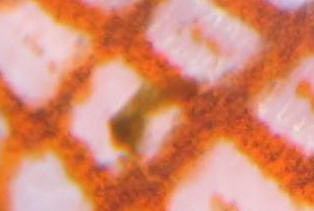 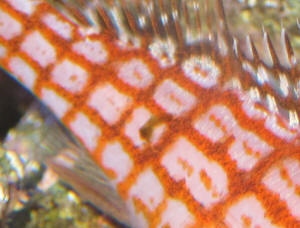
|
Tiny whitish 'egg' on Banggai fin
4/28/11
Sigh. I quarantined my pair of Banggai Cardinalfish for a month, and
put them in my DT yesterday. Now today I noticed something weird on one
of them (but not the other).
I can't believe that I missed it during quarantine, but I might
have.
On the fin over its left gill, there is attached to the fin a whitish
cylindrical thing about 1 mm long and 1/2 mm in diameter.
What is interesting is that it has a slightly smaller version of the
same thing attached to the exact same spot on the fin on the right
side!
This is definitely not a 'white spot' as in the several
diseases. This is an actual object attached to the top end of the fin
about 2 mm from where the fin attaches to the body.
I looked through several references of external parasites, including
parasitic copepods, and I can't find anything that looks remotely
like this.
It is smooth, and I'd almost swear it's an egg, except that
it's clearly attached to the edge of the fin in some way.
I hate to stress the fish by netting it and giving it a freshwater
bath.
(I don't have any treatment chemicals here, and getting out to get
something in the next day or two would be difficult).
Should I try a bath? Or just wait it out? I sure hate to contaminate
the main tank, now that the fish is in it!!
Thanks for any advice!
Tim
<I've seen these unusual protuberances on different marine fish
before, particularly crepuscular or nocturnal species like Cardinalfish
and Soldierfish and they appear to be something like a copepod or
isopod. Copepods, in particular come in many forms. They may be similar
to the ones commonly found on shrimps of the genus Lysmata. They do not
seem to affect the animals in a way that hinders their normal behavior.
The other possibility is that they may be flukes. Both parasites are
rather unsightly, though and if large enough, may affect the
fishes' equilibrium.
It seems to me that some of these parasites are embedded in the skin
while others are loosely attached and might be easily
removed...although cautiously! This is merely an opinion based on your
description so,
honestly, a photo may be more useful for positive identification!
Good Luck! Send a pic if possible!
Sam Scalz>
Whitish egg on Banggai Cardinal (More information!)
4/30/11
Hi. Sorry for the repetition, but I just got more information. Here is
my prior email, with the new information added. Once again, I'm
sorry to trouble you with the repeated email.
<No worries. Sam appears to be "out", so I'm
responding>
Sigh. I quarantined my pair of Banggai Cardinalfish for a month, and
put them in my DT yesterday. Now today I noticed something weird on one
of them (but not the other).
I can't believe that I missed it during quarantine, but I might
have.
On the fin over its left gill, there is attached to the fin a whitish
cylindrical thing about 1 mm long and 1/2 mm in diameter.
What is interesting is that it has a slightly smaller version of the
same thing attached to the exact same spot on the fin on the right
side!
<More and more curious>
This is definitely not a 'white spot' as in the several
diseases. This is an actual object attached to the top end of the fin
about 2 mm from where the fin attaches to the body.
I looked through several references of external parasites, including
parasitic copepods, and I can't find anything that looks remotely
like this.
<Many parasitic ones look nothing like crustaceans>
It is smooth, and I'd almost swear it's an egg, except that
it's clearly attached to the edge of the fin in some way.
<Might actually be eggs... as you likely are aware, Apogonids are
mouthbrooders... these may be "escapees">
I hate to stress the fish by netting it and giving it a freshwater
bath.
(I don't have any treatment chemicals here, and getting out to get
something in the next day or two would be difficult).
Should I try a bath? Or just wait it out?
<This last is what I'd do>
I sure hate to contaminate the main tank, now that the fish is in
it!!
<Not to panic>
Thanks for any advice!
New info: I put a big magnifier on the tank wall and got a close look
at the thing. It is featureless. I looked at many pictures of parasitic
pods et cetera, and those pics always show 'creature features'
like legs, lobster tail, et cetera. This has no such thing. it is
perfectly smooth, featureless, and egg shaped.
<Bingo>
In fact, I could almost believe that it is a tumor of some sort, a
bulbous thing attached to the fin.
<Not on both sides, no>
And I do find it an interesting coincidence (?) that it has a smaller
mate in exactly the same spot on the other side. (The other cardinal
has no such thing.)
<The female...>
Thanks!
Tim
<Do see the Net re Pterapogon reproduction. Bob Fenner>
Re: Whitish egg on Banggai Cardinal (More
information!) 4/30/11
Bob - Thank you for the extended response! An egg? Interesting
possibility. I never thought of that.
I am keeping a close eye on it. The fish seems perfectly healthy,
swimming happily with its friend and eating voraciously. So I'll
just wait and see.
Meanwhile, I'm keeping a close watch on the water. Ammonia,
nitrite, and even nitrate are all perfect zeros, so the fish is getting
all I can give right now.
I'm discovering something annoying about myself and this new hobby:
I may be too much of a worrier to keep fish.
<Mmm, well, on the other hand, It's my long opinion that the
hobby is good for "teaching patience" and much more>
Every time I see even the tiniest imperfection in one of them, I
imagine the worst and spend the next ten hours searching the web and
books for hints about what might be wrong. I'll have to either
toughen up or get a new hobby.
Tim
<Or more learning perhaps. IF you lived nearby I'd loan you a
copy of Ed Noga, "Fish Disease, Diagnosis & Treatment",
either edition... and have you read, go through the front section on
"trouble shooting". Again, not to worry. Worrying will
assuredly not change the future. BobF>
Parasitic Copepod 8/5/10
Hello crew and thanks for all the great advice over the years.
<Thank you Susan>
I Have QT'd 100 lbs of live rock for 4 weeks and have placed it
into a new 125 g RR tank with 35g sump that has been cycled for 2
months. I cleaned out the filter sox and found a 4 inch Polychaete and
a lot of copepods in the bottom of the sox. After dumping the contents
of the filter sox into a bucket I watched two of the round copepods
attach to the Polychaete. The Polychaete was immediately in distress.
After seeing this I am concerned about what is still potentially in the
tank when I start adding fish to the system this weekend. My question
is
should I be concerned about this observation?
<Mmm, I don't think I would be. There are probably close to 7500
species of copepods with about 2000 of these being parasitic. Some of
these parasitical copepods can be quite large measuring over a foot
long. With that being said, it is very rare that a parasitical copepod
will find it's way into an aquarium. There are an occasional few
that will feed on corals, but rarely any that will affect fish.
Bob may add further input here.> <<Most that do so, "come
in" with them on them, and most of these are embedded partly...
and removed/removable with tweezers, the intermediate forms if there
are any, treatable w/ chemicals toxic to crustaceans... posted on WWM.
The more free-living species are best treated chemically, and the more
"embedded" ones tend to be quite species-specific.
RMF>>
The QT process will only eliminate those organisms that can not find a
host in the 4 week time for QT. So I assume there is a good chance that
parasitic copepods are present in most systems but only latch onto fish
under
certain circumstances. Please let me know if this observation is likely
to lead to a bigger problem when the fish are introduced.
<The parasites that concern us is a ciliate protozoan known as
Cryptocaryon irritans which
leads to Cryptocaryoniasis, a parasitical disease (ich) which usually
proves fatal if not treated promptly.
These Protozoans in their free swimming stage are not visible with the
human eye. Your method of QT
should eliminate any of these life threatening Protozoans if
present.>
Thanks again for your help.
<You're welcome. James (Salty Dog)>
Regards
|
Re: HELP female Crosshatch Trigger carrying parasites?
7/29/10
Dear WWM Crew,
<Will>
I have had a 6-7" male Crosshatch Trigger in my QT for 3
weeks now and I decided to pair him up with a female so I got a
6" female on past Tuesday.
I divided the tank in the middle with egg crate so he
wouldn't harm her since I want them to check each other out
for the duration of the QT and because a 55 gallon may not give
her enough room to hide.
After drip acclimation, I put her in and minutes later I see a
hundred or so tiny things swimming all over. I do have some LR in
the QT so what could these little things be? The swim erratically
and under magnifying glass, they looked like they had eyes and
oblong shape with a tiny bit of color towards one end.
<Mmm, sounds like Trematodes, flukes... Actually quite common,
generally not-too-deleterious parasitic worms of marine fishes.
Not hard to treat...
Please read here: http://wetwebmedia.com/fshwrmdisflukef.htm
and the linked FAQs files above>
Is it some parasitic hitchhiker that came with my female or some
invert had babies from the LR?
<On the Xanthichthys themselves almost assuredly. Trematodes
tend to be pretty species-specific>
Sorry, too small to photograph and they are now all dead anyway
since they got sucked up into the hang on back filter. If
parasitic, what treatment do you recommend?
<See the referred files>
Also, how do I know when to take out the divider?
<When you can be there to observe these fish full-time>
I have a 300 gallon circular tank that will be ready for fish in
2-3 weeks (going fallow, in it's 8th week),
I plan to put the female in 1st and then the male, leaving them
separated till moving them into the 300 tank. Is that smart or
should I take out the divider beforehand?
<I would wait, introduce to the main, larger system at the
same time... Very likely there will be no problems there>
Thanks.... you guys are GREAT !!
Bill
<Welcome. Bob Fenner>
Re: HELP female Crosshatch Trigger carrying parasites?
7/29/10
Dear Bob,
<W>
Thank you for your quick reply. I thought flukes detach from the
host only when you dip the host in fresh water
<? What? Where did you get such an understanding from?>
so how can it be flukes if I never gave the female Crosshatch a
fresh water dip? She went from drip acclimation straight to the
QT tank and that's when I saw all the free swimming things.
flukes looks more flat right?
<... see the Net or books re>
These things didn't look flat, they looked like some kind of
baby invertebrate.
<What?>
If you still think it's fluke, I do have PraziPro but I want
her to be eating before I start the treatment, is that ok since I
understand they lose appetite when on treatment. I got her on
Tuesday and she still has not eaten.
What do you recommend?
<Keep reading. B>
Thanks again,
Bill
Re: HELP female Crosshatch Trigger carrying parasites?
7/30/2010
Dear Bob,
<WW>
I definitely trust your opinion and after reading up on this
subject I started dosing PraziPro in my QT tank.
<Mmm, naught to do w/ trust... Really, the only means of being
(more) assured of what these are is microscopic examination.
Symptomatically I suggest/ed they might be monogenetic
Trematodes... If so, likely a treatment w/
Praziquantel will rid your fishes of them>
Going to do 2 rounds of treatment and maybe even do a Formalin
dip.
<Mmm, I'd hold off on the Formalin>
Thanks a lot,
Bill
<Welcome. B>
Re: HELP female Crosshatch Trigger carrying
parasites? 8/2/10
Dear Bob,
<Will>
I was able to catch a couple of these free swimming things in the
tank. I put them in a glass cup and I first dosed it with
PraziPro but that did not kill it.
<Won't kill immediately...>
Then I put then in fresh water for like 4 minutes and that slowed
them down but they survived. I can see little legs moving
<?! Not flatworms then>
so I added Methylene blue to the water and that didn't do
much either. I'm using a jewelry loupe to look at them from
underneath the glass.
So what kills these things?? Formalin 3 baths?
<Formalin kills all forms of higher than viral life...
crosslinks peptides>
My female still has not touched any food in QT, I assume that the
PraziPro treatment is not working so what next?
<Determining "what" you are dealing with
here>
Leaving for vacation in 10 days, need to take care of this
urgently.
Thanks,
Bill.
<Photographs... borrow a close up lens, or a dissection
'scope... I use a cheapy QX series for such. BobF>
Re: HELP female Crosshatch Trigger carrying parasites?
with PHOTOS 8/2/10
Dear Bob,
<Woo>
Here we go, got pics from using a loupe and a good camera.
<Ah, good>
I hope these are the things I was talking to you about. The Blue
is from Methylene blue I used.
Please i.d this bug for me so you can tell me how to treat my
female Crosshatch.
Thanks,
Bill
<Appears to be copepod-ish... For sure crustacean. Read
here:
http://wetwebmedia.com/crustdisfaqs1.htm
re organophosphate et al. cures.
B>
|
  |
|
Flame angel and clown fish parasite question, reading
re ID and more 3/26/10
Hi to everyone! Chris K here (again)
<Howdy Chris>
It seems that I have been writing to you alot <no such
word> lately and I do apologize for the bother.
<Not a bother. We are here to help (and inspire) you and other
petfish friends and soon to be friends>
A few days ago I noticed what I believe to be some sort of gill
fluke?
(parasite anyway) attached to my flame angels gill.
<Really? Can you take a well-resolved image of what you're
observing and send it along?>
The flame is eating and acting normal. So I have been waiting a
few days to see if my skunk cleaner shrimp or neon gobies would
help. This fish is not a new fish, I have added no new fish to
the aquarium recently, however I did add a few new corals just
before I noticed the critter - its never been a problem before so
I wonder if the new coral could be the cause.
The critter appears to be black with what looks like a white
tail.
<Mmm, could be a few things... perhaps a parasitic Copepod of
some sort>
Today I notice another one on his other side.
I am wondering what if anything I should do at this point-
because I don't think the cleaner shrimp is handling the
situation very well.
<May be too big, distasteful for its removal>
The flame is still colorful, active and eating like a pig. I
would like your advice on the best thing to do at this point -
because I am pretty sure its going to involve tearing my tank
down to catch the little darling.
<I would be reading re the identification of crustacean
parasites, perhaps worms as well... and their treatment. If this
"tail" is a reproductive process... you may well have
many more of these soon>
Also my ocellaris clowns seem to have an interesting symptom. I
have noticed that they poop white - but not the long stringy
stuff that I would normally associate with a parasite infection,
but rather an "explosion" of many (a shocking amount to
me) of - shorter stringy white things that look like tiny worms.
The "worms" don't appear to be alive, but with the
movement of the water who can tell? The clowns seem to be acting
quite normal as well.
<A good opportunity re the "Worm parasite" reading
again...>
I appreciate any help you can give. Thanking you in advance!
Chris K
<Posted. Read here: http://wetwebmedia.com/mardisindex.htm
scroll down to the specified trays, read. Bob Fenner>
Re: Flame angel and clown fish
parasite question 3/26/10
Oh thank goodness - Bob I do so much appreciate your response. I
have attached two of the best photos that I could get - they are
a little blurry - I am going to work on getting a clearer shot -
I think you are able to notice the black spot with the white tail
hanging off his gill near his front fin in both the photos.
(another one smaller one forming on the other side, but too small
to get a picture)
<I can barely make this out>
I managed to catch him and give him a fresh water dip - but the
thing did not fall off. I am floating him in my aquarium right
now, while I get a QT tank set up - do you have any suggestions
based on the photos?
Chris k
<Yes... an organophosphate... per where you were prev.
referred for Crustacean parasites. BobF>
|
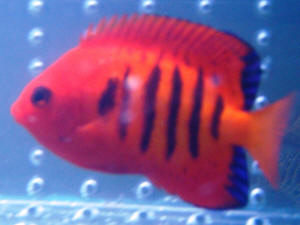 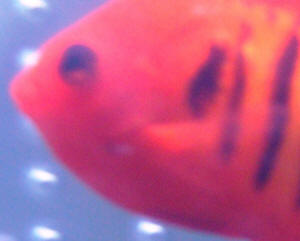 |
Lump on yellow coral goby 1/25/2009
Hi there,
How are you?
<Fine, thanks>
I'm just writing (again) to ask about this lump I noticed on my
yellow coral goby today. It's on the anal fin (is that what
it's called? I'm not too sure...) and it's sort of in a
rectangular shape, about 1-1.5mm long.
It sticks out like a lump, and it's the color is very very light
brown with a tinge of pink perhaps... definitely not yellow. It looks
almost like a skin tag, or a blister. At first, I thought it was from
physical trauma since I had read about it in the FAQs a few weeks
ago... but then I noticed one or two really tiny black dots at one end
of the 'lump', and thought it almost looks like eyes of some
sort.
<Mmmm>
Could this be a parasite attached to my fish?
<Possibly>
The fish hasn't shown any symptoms though... and from the size of
the lump, I would have thought there would be other symptoms. If
anything, over the past two days, my fish has been eating a lot more
than before, since it'd seem to be starving until recently. I'm
not sure what to do really, because currently I have a threadfin
butterfly in my QT (bought it a few days ago) so I don't know if I
should put the coral goby in my QT as well.
Thanks,
KC
<Maybe try adding a purposeful cleaner (perhaps a Lysmata species),
read here: http://wetwebmedia.com/clnrfaqs.htm
or net the Gobiodon and try removing this spot for closer examination.
Bob Fenner>
Re: lump on yellow coral goby - 1/25/10
Hi Bob,
<Kitty>
I managed to net the goby to have a closer look at it. It looked like a
worm of some sort that was clinging onto its anal fin. When I pinched
it with a tweezers, it started running up the goby's body so I was
able to grab it and it came off easily. It had these tiny little
shrimp-looking legs though..
<Ahh! Likely a parasitic crustacean of some sort...>
whatever it was. I'll definitely look into getting a cleaner shrimp
or something similar once my butterfly's out of the QT.
Thanks for your advice and help!
KC
<Please read here re: http://wetwebmedia.com/crustdisfaqs1.htm
BobF>
Solicit information and cooperation
12/12/09
Dear sirs, this intended and to greet you, and solicit your cooperation
on the following. Recently I was looking the wetwebmedia.com/gobies and
I found photographs of gobiids parasitized with copepods. Related with
this I need
to known if it is possible to get these photographs for personal use
only, that mean for comparison with others copepods.
<I have just looked for these... under both my Crustacean, Copepod
pix and Gobioid... Bryaninops loki images, and don't see... have
had some very trying issues with my desktop computer recently>
Also , as I am working with the identification of some Pennellidae
(parasitic copepods),also I would like to know if it is possible to get
samples of that kind of gobiids in order to examine the parasite for
comparison wit other pennelids which actually I am reviewing.
<I don't have such specimens myself. I would refer you to Dr.
Jack Randall of the Bernice P. Bishop Museum in Hawaii for further
referral in turn. I will BCC him here>
Please I´ll be grateful for your answer.
Raul Castro R
Universidad de Antofagasta
Depto Acuicultura
Antofagasta
Chile
|
Parasite on New Cleaner Shrimp - 2/18/08
Hi, Great website by the way! <Thanks, Ed! It's a
collective treasure, isn't it!> I recently purchased a
Skunk Cleaner Shrimp <Lysmata spp.> and I am having some
difficulty with it. It is living in my FOWLR tank on its own and
there are some things I don't understand. <Alright,
let's see if we can't figure them out.> 1) There is a
peach coloured, bubble type of growth on the side of the shrimp,
is it a parasite or will it go at the next molt? <This is a
blood-sucking parasite, generally called a Eucarid or Bopyrid
Isopod. We see them occasionally on shrimp, especially in the
genus Lysmata (cleaner shrimps). These parasites don't come
off when the shrimp molts and they're next to impossible to
remove without killing the host. The growth you see is actually a
female isopod that before it attached, looked like a typical
small 'rolly poly' isopod. These organisms attach
themselves to a shrimp, bury under the carapace, and change form
into what appears to be a whitish tumor/mass. Color can vary
based on the hue of the overlying carapace. The good news is that
although unsightly, these parasites do not necessarily kill the
host. Nor do they pose a likely threat to any future shrimps in
your system. This is because they require an intermediate host, a
type of copepod, that isn't normally found in aquaria. One
thing of note however, is that although these don't actually
kill the shrimp by themselves, they can weaken it as well as
render it sterile. A shrimp with one of these parasites attached
is not going to be as strong as one without. It's going to be
more susceptible to changes in its environment, such as water
chemistry, etc.> 2) The shrimp appears to be having some
difficulty swimming vertically, and does not get very far before
it sinks, could this be because of the growth? <Yes, it's
possible.> 3) I am having trouble feeding the shrimp. I am
trying to feed it Hikari small marine pellets, are they correct
for a shrimp? <My experience is that they'll eat just
about anything: sinking pellets, small meaty bits of marine
origin, flake food, small worms, etc. Just make sure that
it's getting a varied diet.> ..and finally, 4) The shrimp
never really seems to venture out when the aquarium lights are
on, but as soon as they are switched off begins exploring the
tank, is there anything I can do to help this? <This may
change as the shrimp becomes more accustomed to its surroundings
(as long as no predatory fish are introduced!). Part of this
behavior may be a function of its slightly weakened state. For
example, when shrimps molt, they instinctively hide because they
know they're vulnerable. Your shrimp could well realize that
it's not a hundred percent and be a bit more cautious. For
more information/photos regarding these parasites, please see the
following links:
http://www.qualitymarineusa.com/article.asp?page=feature&id=968EF63B-2D1D-469A-847A-8E8541B12BE4
http://home2.pacific.net.ph/~sweetyummy42/hitchshrimp.html>
Thanks for all your help as I am new to marine fishkeeping. Many
thanks Ed. <You're very welcome, Ed! You've come to
the right place! Please let us know if there's anything else
we can help you with. Best wishes to you and your little cleaner
shrimp. Take care, -Lynn>
Re: Parasite on New Cleaner Shrimp
- -02/20/08 <Good morning, Ed!> Thank you
for your help regarding my last shrimpy questions, <You're
very welcome!> ..but after reading the articles on one of your
links, it appears that the parasite (Eucarid) can be removed from
the host shrimp, and that the shrimp will make a full recovery.
<Hmmm, yes, it can be done, but it sounds like a potentially
tricky (and risky for the patient) procedure, particularly if
you've never done it before. You've got to have a pair of
very fine tweezers, or the like, as well as know the anatomy of
the shrimp so that you don't go in at the wrong place.
Furthermore, the shrimp is not anesthetized. You've got to
capture it, turn it upside down and keep it still in that
position under water, reach in at the right spot with fine
tweezers. taking care not to puncture the body -- during which
time, the shrimp is most likely trying to get away. I've seen
reptiles and sharks enter a sort of catatonic state when
they're upside down. I'm not sure if shrimp react
similarly. At this point, you have to determine which is more
life threatening -- the actual parasite or the removal
procedure?> Would you recommend this procedure?
<Personally, I wouldn't do it and wouldn't recommend
it. The shrimp can survive with the parasite and there's
little, if any, risk to the rest of the livestock. More
importantly, the shrimp is a new addition, already dealing with
enough stress. I'm not sure it would survive the
procedure.> Many thanks again, Ed <You're most welcome.
Take care, -Lynn>
|
| Parasite, Copepod... 2/10/08
Here are some pics of a nasty looking parasite on a Stonogobiops
nematodes. The fish is a juvenile, about an inch long. He is very
active. Eating very well, and you would never know he has a
problem. <"Successful parasites don't kill their
hosts"> The parasite has a blood red abdomen, two
curlicue's at the top, <Egg sacs...> and what looks like
a mosquito's proboscis entering the fish. Looks like a salt
water Mosquito! <Is a copepod> I have been trying hard to
research this, but have had no luck with identification. From
reading all the threads that I could, the two courses of action
seem to be, one, cleaner shrimp. And then if unsuccessful, manual
extraction with tweezers, in a net, under water. <Mmm,
dangerous> The fish is so small, I am afraid to handle him. But
if I did remove it manually, I was unfamiliar with the medication
to swab on the wound, and where to get it. Any help with
identification, and a plan of action, would be appreciated. Sorry
if the pics are not in perfect focus. These are the best I can come
up with, I took fifty, to get these four. Thank you! Richard PS I
put the smallest cleaner shrimp that I could find in the tank
tonight. I will keep my fingers crossed. <This is a very good
idea... I would "just wait" at this junction... Likely
trying to extricate or selectively poison (organophosphate) this
crustacean will result in the goby's death... Perhaps it will
"cycle off" in time... and there is a good chance that it
cannot reproduce in your setting... see the Net re... I would just
be patient... it may take months to change... Bob Fenner> |
|
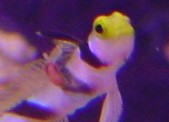 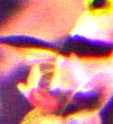
|
|
Unusual growth on Purple Tang (Zebrasoma xanthurum)
12/10/07 Hello Crew, <Ron> Thanks for taking the time
to review my query! For the first time today, I noticed a dark
fuzzy/hairy growth on my Purple Tang (Zebrasoma xanthurum) --
passengers side near the tail. ; ) I have searched the web and
WWM but can't seem to find anything that fits the profile of
a dark gray/black 'hairy' growth. <Could you send
along a well-resolved pic? Oh, I see the links below> Nobody
in my local Reef Club (RASOC) had any suggestion either. It seems
that most accounts of spots or growths on fish are white, unless
it involves black speckles or a generally discolored spot.
Perhaps my search query is lacking some keyword. However, I would
definitely have to describe this growth as hairy or fuzzy in
appearance since it appears to be a cluster of 'hairs'.
When I look back at earlier pictures that I have taken, I can see
that this spot was there in some form a month ago. It is
approximately 2 mm in diameter. It doesn't seem to bother the
Tang as far as I can tell. I have an active Cleaner Shrimp and he
doesn't seem to be concerned about it either. Here are the
best pics I can get of the growth. I am providing a couple of
flickr links in lieu of sending pictures that may be too large
(hope that is ok). Feel free to upload and post if you desire.
http://farm3.static.flickr.com/2022/2098256828_b98c969b7d.jpg
http://farm3.static.flickr.com/2188/2097478823_335152a998.jpg Do
you have any idea what it could be?? If so, would you recommend
treatment or merely observation for now? Ron
<")))>< Charlotte, NC <Might be a crustacean
parasite... looks in outline like a pair/two copepods... A shame
to stress this animal by netting, but if the occasion presents
itself, I would use two nets, capture this fish and gently try
prising off this mark with blunt nose tongs (ask your wife re
maybe...). IF there is any sign of blood from doing so, do daub
(with a "Q tip") a bit of
mercurochrome/Merthiolate/Merbromin on to the spot. I see what
appears to be the antennae of a Lysmata sp. in the background...
In time, this cleaner may remove this mark... Otherwise, I doubt
if it is really debilitating, and strongly sense that it is not
"catching". Cheers, Bob Fenner>
Re: Unusual growth on Purple Tang (Zebrasoma xanthurum)
12/10/07 Bob, <RonF> Thank you for the information you
provided. The pictures closely represent the view one gets with
the naked eye. Perhaps I will try to use my digital zoom to get a
closer pic, in order to see if it is indeed some sort of
crustacean. I am hesitant to stress the Tang out by netting it,
as you alluded. For now, I will observe and hope that the Cleaner
ultimately resolves the issue. Ron <")))>< <Ahh!
This is what I would do as well. Cheers, BobF>
|
|
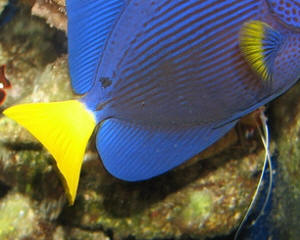
|
Parasitic copepods? 10/17/07 Hi there! <DJ> I have
been getting some fish in from the Marshall islands and some
locally in Hawaii that have these bumps (usually on the
fins/tails) of some fish. Mainly butterflies and tangs -
majority yellow tangs. I attached a few pictures of 3 pyramid
butterflies that have them (they are in a reef tank after I sent
them out) My question is are they something to be concerned
about? <Mmm, possibly... as am sure their presence is at least
somewhat debilitating... as well as unpleasant to look at>
Usually I just rip them off with tweezers or clip them off, but I
do miss a lot of them. I don't see them spread or anything,
but am concerned about the one butterfly who has them on its
side. <Can spread in systems at times...> Thank you so much
for the help. Aloha DJ <I would treat the incoming fishes with
a dilute freshwater, pH-adjusted formalin bath as spec.ed on
WWM... and their intermediate holding systems with an
organophosphate... likely DTHP or Dimilin... commercial products
of such also spec.ed on WWM. Bob Fenner>
Re: parasitic copepods? -- 10/18/07 Mr.
Fenner, <Just Bob, please> Thank you for the quick
response. I run my system water (am a wholesaler in Hawaii)
<Oh! We may well know some of the same folks... Furry
Slippers/RandyF on O'ahu... Mr. Fish/Steve, Dave Dart...
others on the Big Island...> with Nitrofurazone and copper
(about half dose each) consistently. Freshwater doesn't seem
to knock these things off. Would formalin work better? <Yes it
would, but the real deal is a dose or three with the
pesticide...> My other question is would they spread to other
fish in a closed system? <Possibly... though most worm and
crustacean complaints tend to be more species, genus, to family
specific... Also depends on how simple/complex the critters life
cycles are... I suspect these may be direct... i.e. not require
an intermediate host> The 3 butterflies are in with some
wrasses and tangs. I just don't want them to spread and take
over. <Agreed...> Thank you for the reply Aloha DJ <A
hu'i hou! Bob Fenner>
Re: parasitic copepods? -- 10/18/07 I know
Randy and a few others on Oahu. I don't know many on the big
island though. Am not a big enough wholesaler to bring in large
quantities of fish the big island :) <I see. Say hello to
Furry Slippers for me> What pesticide would work best? do you
have a link or something where I can buy it? <Please read
here: http://www.wetwebmedia.com/crustdisfaqs1.htm and the linked
files where you encounter them there> Thanks again for the
help.
DJ
<Welcome. Bob Fenner>
|
|
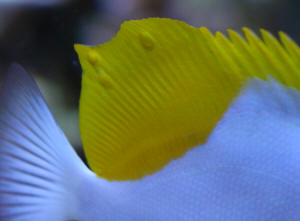 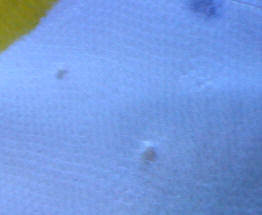
|
Things on Goby? 5/9/07 I just received a
red banded antennae goby from a distributor, and I noticed that the
little guy has two red, sausage looking blobs on either side of his
body. They are not on his head or gills, but rather about
halfway down his body, right behind his stomach/intestinal
area. One blob is about a millimeter, the other slightly
smaller. They are red, but still semi transparent. When you
look closely, you can see something undulating inside of
them. It is a bottom to top motion, no squirming or writhing
inside. Also, the larger of the two sausages has a small
yellowish "string" coming from the top of it. I do not have a
camera here (I'm at work) so I cannot attach a picture.
<Rats!> I was looking through all our fish books and cannot find
an external parasite picture that matches these things. My
question is, any idea what it is? <Yes... very likely either a
crustacean or worm parasite... Not uncommon> It almost looks like
the little guy's organs are on the outside of his
body! Especially as the two are directly across from each
other, one on either side of his body. Any help would be
appreciated. I do not want to put the poor thing in any of
our tanks until I'm 110% what it is. Our quarantine tank
is way to big for him, I'd never find him or he'd get eaten by
the puffer we have in there. Thank you! -Erica <Mmm, I
suggest serial administration of an anthelminthic (my choice?
Praziquantel), and an Organophosphate (something like Fluke Tabs)...
Please read here: http://www.wetwebmedia.com/gobydisfaqs.htm re related,
cautionary remarks/matters. Bob Fenner>
Blood sucking insect/parasite? SW crust.
parasite? 2/3/07 Hi everyone at WWM, <Barbara>
I recently have become addicted to your very useful and
informative website, my appreciation to all that goes into it! The
following question is the only thing so far I have not found
information on in it! My tank is 30 gals, 32lbs live rock,
sg-1.023-1.024, Ammonia-0, nitrites-0, nitrates-15-20 ppm, but I am
having luck lowering it with frequent water changes. <Good, one
approach> Current occupants are 1 strawberry Dottyback
(Pseudochromis), 2 false Perculas, 1 algae blenny, and 1 Flame angel, I
realize it is most likely overstocked, <Yes... you are up against
psychological and practical limitations... with the Angel,
Salarias...> but all are doing very well. I just noticed tonight
that my Dottyback has what looks like some sort of "insect"
that seems to be sucking on his tail fin, it's body is blue in
color and is about 1/8" long. The Dottyback does not even seem to
notice it, and is swimming as usual and eating VERY well as always. I
assume whatever it is came from in the live rock, which the Dottyback
always hides and swims in and out of. I just wanted to know if I should
quarantine the Dottyback, do a freshwater dip, etc? <Yes... I would
catch this fish (may require removal of all LR...), and physically
remove this parasite... Likely either an isopod or copepod... but could
be other... and likely leave the wound site as is... unless there is
any sign of bleeding... then would quickly daub with a
"Q-tip" and a bit of Merthiolate or such...> I
couldn't find any information on this particular critter on your
site or the web in general. My thanks for any insight you can offer!
Barbara <And if possible, practical, perhaps a friend can take a few
quick pix... that you might send along. Bob Fenner>
Re: blood sucking insect/parasite follow-up
2/4/07 Hi Bob, Thank you very much for your quick
reply! A few hours after I noticed it the insect fell off
(disengaged?) There is no bleeding, just a slightly noticeable spot
where the insect was. If I see it again I will get a picture and
forward it. No easy way to describe it other than a blue colored bug!
Thank you again for your advice! Barbara <Thank you for this
update... I do hope this was an arthropod (not a worm species),
separate sexed... consequently not able to/going to reproduce here. Bob
Fenner>
Gill problem... Do "we" stay in Iraq
or...? 12/16/06 Hi Crew, I have a 10 gallon with a pair
of neon gobies (wild caught) that I bought back in July. <Neat>
Shortly after I got them I noticed 2 white lines in the gill of one
goby. It looks like small sticks of chalk. <Ahh!> This goby does
breath much faster than its mate and is slightly smaller. I thought
about trying to remove it with tweezers (and got an affirmative from
the Crew to try) but never got up the courage. <Is a bit
"tricky"... easy to greatly damage the fish host... any
bleeding is a very bad sign... best to daub the area with dilute
Povidone Iodine...> Anyway, here we are a few months later with
everything about the same. They are both very active and eat well. At
this point is there any reason to attempt to remove it? Or am I more
likely to do more harm than good? <An important, though impossible
to answer question... As (if we look) we are often "faced"
(if honest...) with similar questions, issues in our lives... "Do
no harm" is a useful creed/oath of western doctors as well as
would-be earnest aquarists... If the fish in question indeed
doesn't appear debilitated, I would leave this likely crustacean
parasite be... not likely to spread (as are to a large degree
species-specific AND complex in life cycles... Bob Fenner>
| Fish Parasite
<copepod> 12/14/06 Hi, <Hello there>
Attached is a picture of my Firefish with an attached parasite
behind the right fin. <I see it> I was not smart enough or
patient enough to follow the quarantine advice from your Marine
Aquarist book. I really enjoyed the book by the way. I
find myself rereading it often. I would appreciate any information
about this parasite you could give me. Thank you, Paul Hug
<Appears to be a Copepod... the trailing "egg sacs"
are indicative to definitive. Please read here re: http://www.wetwebmedia.com/crustdisfaqs1.htm I would
(gingerly) remove this from the fish using a tweezers... pulling
away, toward the tail... with the fish netted, underwater... Bob
Fenner> |
| Re: Fish Parasite 12/14/06 Thank
you for the response. I am hoping you can give me some
advise on what to do next. <Okay> I removed the Firefish,
Nemateleotris magnifica, from my main tank. I then removed the
parasite using tweezers. The parasite stretched during
removal making me think it was a worm. The
'"Thing" on Firefish' letter sounds exactly like
mine. The curlicue description fits. <Mmm, I do wish
I would have remembered to include a note re grasping the
"worm" (like previously stated this is actually a
crustacean)... near, by the head... pulling firmly, though slowly
from there... to prevent breaking the Copepod...> I quickly set
up a new 10 gallon tank as a quarantine/hospital tank and moved the
Firefish and my only other fish, a diamond goby, Valenciennea
puellaris, to this new tank. <Mmm, okay... though likely
unnecessary... The parasite likely has a "complex" life
cycle... requiring the presence of at least another intermediary
organism (which is highly likely not present)> My two week old
105 gallon main tank now contains base rock, live rock, sand from
another running aquarium, 29 miscellaneous snails, 15 hermits, 2
Cleaner Shrimp (Lysmata amboinensis), and 6 mushroom corals
(Discosoma sp.). This tank with some live rock and sand from an
active system shows now ammonia or nitrite. Nitrates are
currently 20 ppm (This is a decrease from 1st week at 30 ppm).
<Good> This afternoon the Firefish died. I am
pretty sure I stressed it during removal and by the delay in
getting it into the new quarantine tank. <Very likely... sorry
for your loss> Should I medicate the diamond goby (no symptoms)?
<I would not... not worth the further stress, small likelihood
that this is something "treat-able"> I
assume that leaving the goby in the quarantine tank and leaving the
main tank fishless is a good idea. <Mmm... not really
necessary> If so, how long would you recommend and should I do
anything else to reduce/eliminate the possibility of transmission?
<Use of practical cleaner organism/s here...>
Also my quarantine tank was purchase/setup in a hurry
so I ended up with a cheap incandescent hood. Is this a problem,
other than heat, for the diamond goby? Thank you, Paul Hug <Not
a problem. Paul... please do read re Dart Gobies, Microdesmids...
most of the species used in our interest really need to be in
pairs... Bob Fenner> |
|
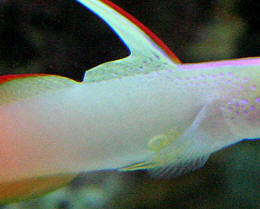
|
Locally Introduced Parasites? - 10/23/06 Hello,
<<Howdy>> I hope you can help me. <<I will
try>> I have searched your web site for answers with no
avail. I have a 55g SW tank that is about 3 months
old. My fish are dying! <<...!>> I had 4 king
fish native to NJ Atlantic Ocean where I live, <<Hmm...there are
"several dozen" species of fish with the common name of
"kingfish"...I'll take a guess that these are
Menticirrhus americanus...an attractive "mottled" species of
croaker that gets too large for this tank (over 20") and is also a
"subtropical" species not suitable for a "tropical"
marine system>> 1 three-stripe damsel, 1 percula clown, 1 ocean
crab, 1 star fish, 1 cleaner shrimp, 1 peppermint shrimp and 5 turbo
snails. About 10 days ago I lost 2 of my king
fish. A few days later I noticed hundreds of tiny bugs
darting on the tank glass and swimming in the water. <<Normally I
would think these to be beneficial and harmless copepods; but I'm
guessing you collected the kingfish and the "ocean crab"
locally, yes?...and maybe more?...some sand/rubble/rock?>> These
bugs also seem to be attaching themselves to the fish at night,
especially the clown fish. <<Uh-oh>> The fish have been
eating the bugs off the glass and the damsel was pecking at the clown,
cleaner shrimp is lazy. Anyway this morning my other two king fish were
dead and hours later the clown died. The damsel seems to
have lost his dark black stripes they are turning gray, especially the
one down the front of his head. <<Stress>> Also the fish
were jerking and sometimes scratching on the coral. The damsel is the
only fish left in the tank besides my inverts which are doing fine.
<<As would be expected if these "bugs" are a parasitic
crustacean>> My water conditions are in the excellent range, no
ammonia, nitrates, nitrite and pH and alkalinity is great. I
run a wet/dry filter. Any help would be
great. Please help me! <<Is it possible you introduced
a parasite (collected locally) that has quickly reproduced in your
system and attacked your fishes? You should remove the
remaining fish to a treatment tank and let your display tank sit fallow
for 6-8 weeks...the inverts should be fine. As for
treatment, whether to use ionic copper or an organophosphate treatment
depends greatly upon identifying the parasite (e.g. - protozoan vs.
Isopod). I would probably try the copper treatment (as you
would for Ich). And do have a look here and among the
associated links for more clues/strategies: http://www.wetwebmedia.com/parasiti.htm >> Thanks,
Laura <<Regards, EricR>>
Fish Lice/leech? 7/4/06 Hello
there!!! I have a question on the fish I just bought about 2
weeks ago. It is a six line wrasse. Just about 1
week ago, I noticed an oval shaped patch on the side of my
fish. That little patch even moves around. It tends to stay
on the side of the body only. I have done some research and
narrowed it down to either a fish lice or a leech. I have
noticed that when the patch moves or stretches along the fish's
body, the fish tend to scratch up against a rock. The fish
is still swimming and eating regularly. Its very hard to
catch this fish for treatment because they are so fast and always
darting into caves. If it is a fish lice or leech, will it
eventually kill the fish? <Too possibly so...> As of today, I
only see one of these little fish lice/leech. Do you think
there are more in the water column? <Mmm, not likely. If you are
fortunate...> If so, How do I treat the main tank? <Can be
treated with "economic poisons" that are mainly harmful to
non-vertebrate animals... but...> The main tank has
corals. I'm thinking that the only way to treat the main
tank is to go without fish (the host), for a long time so those fish
lice/leech die off. Am I correct? Thank you.
<You are correct. Now, if it were me/mine, I would make the
concerted effort to remove the live rock, decor, possibly drain a good
deal of the water from this system, and gingerly catch this wrasse
(using two nets as to not knock off or disturb the parasite into
leaving), lift the fish from the water and carefully pries off the
louse... likely an isopod, with blunt forceps... and return the fish to
the tank, along with the decor... Likely this is an
arthropod/crustacean parasite imported with the specimen (you would
have seen it, had less problems had you quarantined...) and has had no
opportunity, mate to reproduce... Bob Fenner>
Re: High Nitrates in a Fishless
Tank 6/5/06... barnacles, alkalinity, sw maint. Lisa,
<Mmm, Bob this time> Back again. It has been a while,
I wanted to test the water and just watch and wait to see if I could
get it together. <Okay> The water I have been
changing faithfully once a week between 5-7 gallons in a 55 gallon tank
and a 29 gallon tank. <Sounds about right> The 55
gal. has no fish still, just the live rock and inverts which seem to be
doing very well. The Caulerpa is thriving as well as all the
inverts. The sponge is growing and the feather dusters are
fine. We do seem to have a lot of barnacles. Is
there such thing as too much? <Mmm, can be... Cirripedians can be
pests/parasites to fishes as larvae...> I just do not like. Going on
12 weeks now after losing all fish... The Nitrates were high and now
seem to be stable at 20 ppm (tap water registers 10ppm) We
do not see a lot of waste in the media of the Fluval. <Canister
filters can be problematical... transient pollution sources>
Ammonia sometimes shows 0 and sometimes
goes up to .25 The nitrites are always 0. The PH
is what really fluctuates. The last check was between
7.8-8.0 It always seems to drop. <A lack of
buffering, restoring chemical make-up... Alkaline reserve>
I am checking the PH on the new water that I am changing
out as it is low and actually raise it high to balance out the low PH
of the tank. <Good... but need to check the alkalinity, not simply
pH> What other suggestions could you recommend. I am
leery of starting over until certain all the water issues are
corrected. <Please read here:
http://wetwebmedia.com/marphalk.htm
and the linked files above> The 29 gal. has live rock and
2 damsels. The water registers 80ppm nitrates, <Way too
high> 0 nitrites, 0-.25 ammonia and Ph also fluctuates
low in this tank as well. Any help is greatly appreciated.
Sandy <... please learn to/use the indices, search tool on WWM... A
link/beginning to nitrates: http://wetwebmedia.com/nitratesmar.htm
Bob Fenner>
"Thing" on Firefish I just purchased a
Firefish on Sunday, and yesterday, Monday, I noticed that he has
something coming out of a hole behind his pectoral fin. The hole is in
his "armpit" and there is not one on the other side. This
thing is a yellow-white curlicue that comes out, and looks like it goes
back into the hole it came out of. It is maybe 1/2 cm long. By curlicue
I mean kinda like wood shaving, or piece of sawdust. He is having no
problems swimming or eating. This thing doesn't seem to be
bothering him at all, but I would like to know what it is and if I can
do anything to make it go away. (The way it is shaped, I think it may
be a piece of intestine, maybe?) Thank you! <Mmm, my guess is that
this is an external parasite... a copepod likely (do put the terms
"copepod fish parasite" in Google and look at the
"images"... Can be excised with forceps likely... and careful
holding while in a net... Bob Fenner>
What are those little bugs?
(2/24/04) Hi, <Howdy. Steve Allen here> I hope
you have the answer. <I'll try.> We have a 55 gal.
saltwater that has been set up for about 5 months. All our
fish are well, level readings are normal. Problem is what
appears to be lice like parasites on the walls of the tank.
<Probably not parasites.> Are they a danger to our fish and how
should we treat them. <Most likely no danger at all. If they
swim/crawl around, they are almost certainly harmless (actually
beneficial) mini-crustaceans known as copepods. "Fish lice"
are isopods that hang directly on fish. If they appear to be attached
to the wall, they may be some sort of harmless marine
worm.> We also noticed larger white parasites that appear
to be snail like with a fan tail, also on the walls of the tank. <Do
they move? May actually be a mini Featherduster worm.> Any advice
would be appreciated. <None of these are likely harmful. Enjoy the
diversity of life in your tank. Read here to be more certain: http://www.wetwebmedia.com/invertidfaq4.htm
http://saltaquarium.about.com/cs/pestscopepods/a/aa061200.htm
http://www.wetwebmedia.com/copepodfaqs.htm
http://www.rshimek.com/Invertebrate%20Key%20to%20Major%20Taxa.htm
> Thank you. <Hope this helps.>
Do White "Hairs" Indicate a Parasite?
4/9/04 BACKGROUND - Friend broke down tank and gave me
a 4" blue tang - The tang has pale pits all over its head
suggesting lateral line disease, though the line looks fine <natural
sunlight and improved feeding will improve this> - Tail is
frayed and oddly bumpy near its base - These symptoms have
remained constant for 6 months <hmmm... does not sound likely
pathogenic for lasting this long without getting better/worse>
- Behavior completely normal for a blue tang (healthy swimming,
appetite, etc) - I have provided no treatment - Goby and
Banggai Cardinal tankmates exhibit no signs of illness NEW
SYMPTOM - I just noticed a series of white "hairs"
sticking out from his back, directly below the dorsal fin.
<odd> - These bristles are parallel to each, angled from
front to back (like hair blowing in the wind), the thickness of thread,
and number about 10. QUESTIONS 1. What's wrong with
this fish? <not sure by the text description... a clear photo
would help. Else do consult a good manual like Untergasser's
Handbook of Fish diseases (TFH)> 2. What should I do to help
him? <ID the symptom first before any move or treatment. Get
your Quarantine tank ready if needed if its not still running>
Thanks in advance for any relevant info/advice. - David
<I see that you are form Boston... do check out the excellent local
club: The Boston Reefers. They have their own website (slips me now...
do a keyword search) and they have a forum on reefcentral.com They are
also hosting the national conference this year in September.. an event
not to be missed! Anthony>
| Parasite on goby? Hello Crew, <Ken> I've got a
yellow watchman goby that I've had for about 8 months. About 2
months ago I noticed that it constantly had its mouth gaping, and
that there appeared to be a white mass on the lower inside of
it's mouth. It was still acting OK and eating, so I just kept
my eye on it. A couple of weeks later I noticed that it had a
1/4" rod shaped projection coming from the side of it's
face. I'm guessing it is some sort of parasite. <Yes, looks
like a parasitic copepod> I tried to catch the fish to isolate
it, but had no luck. Since it does not appear to be contagious,
I've left the fish in the tank rather than tear the whole thing
apart trying to catch it. <These are generally pretty
species-specific. Should not spread> The fish still seems to be
doing fine, and the white mass in the mouth appears to be gone, but
the rod shaped projection has remained about the same. I've
attached a photo of the fish that I took several weeks ago when the
mass was still evident in the mouth. Can you tell me what the cause
of the projection and mass are, and what I should do if anything to
treat the fish. Thanks, Ken <If, when the occasion presents
itself, do pull this off with forceps. Bob Fenner> |
|

|
Are there parasites that you can see? <Oh yes... some
crustacean parasites of fishes and other aquatic animals are quite
large for example... some inches long> After close examination on my
aquarium I notices these extremely small moving creatures in the water,
some walking on the glass. Under a magnifying glass they almost look
like shrimp. Could these be harmful or might they just be something
that the fish stirred up in the sand? <Likely nothing to worry
about. Please read here re: http://www.wetwebmedia.com/pericaridanfaqs.htm
Bob Fenner>
Argulus (marine) Dear WWM Crew, <Howdy> I have a
225g salt water aquarium which houses a Niger Trigger, Naso Tang and a
Zebra eel. The tank is fish only and has a wet/dry filter. My question
is regarding Argulus. I believe I have this due to the actions of the
Niger Trigger. It noticeably rubs onto rocks and flinches a lot.
Yesterday I noticed 3 small oval shaped "lice" looking
parasites moving about it's tail and fins. Yes, they are moving
around. They are about 0.075" in diameter. It's fins have
frayed a little bit but it's color still looks great. The other
fish, as well as the Trigger, are still eating VERY hardily. Does this
sound like a good diagnosis? <It may be that your fish does have
this Branchiuran parasite genus... Do you have access to a
microscope?> I want to treat the tank with "CLOUT" but am
nervous about putting medication in my tank. I am also concerned with
only treating the Trigger because I have read that Argulus lays eggs in
the rocks, so dipping the fish is only a temporary fix. Is this true?
<Yes> Will CLOUT have any effect on the eel, since it doesn't
have scales? How about the wet/dry filter, will there be any damage?
<A bit of a risk, but about the best choice for you here... that or
"Marine Med Aqua" or other organophosphate containing
medications> If CLOUT isn't a good solution, do you have any
recommendations? Thank you very much, Lon <I would try treating the
trigger in a separate system (hospital tank), by itself if it is the
only infested fish of the three... there is a chance that whatever this
parasite is (likely some sort of crustacean) that it is so species
specific in its use of hosts that it will die off in your main system
in a month or so of leaving the trigger out. There is much to relate to
you re your present knowledge of quarantine, treatments... Please read
through the areas you feel you're weak in on WetWebMedia.com on the
Marine Index (Maintenance) and the "Related FAQs" therein.
Bob Fenner>
Buggy parasite prob.s in a new marine system
Hello bob, <Hi there Nino> I have started my first marine tank.
It's now been seven weeks since I have had my tank running. I have
two sleeper gold head goby's in my tank and they seem to have small
bug parasites attached to their fins. The other fish are doing fine but
also where their gills are their seems to be very dark areas. It's
hard to tell you in detail as these fish don't stay still enough
for me to see correctly. the ph is 8.3 the sg is 1.022 and the water
temp is 24 degrees the ammonia is on 0 ppm the nitrate is on 0 ppm.
<Can you describe these "big bugs"? Are they grey in
color, segmented? Any apparent eyes?> if you are able to give me
some help that would be great. As I am at a loss to know what this is.
Also there is 20kg of live rock in the tank. thanks Niño
<Do you have any "cleaner" organisms in your system as
yet? I would study about their use at this point, maybe employ a
Lysmata sp. shrimp to clean out the "bugs"... Please read
about their use (there's a search tool on the bottom of the
homepage: http://www.wetwebmedia.com/ Bob Fenner>
Parasitic crustacean incident? Hi Robert Fenner,
<Salutem dicit> I am writing you because I have a problem of
parasites with my yellow and purple Tang, first I saw small sticks in
the back part, close to the tail, then I introduced a healthy purple
tang, and now the purple tang has the sticks too!!!, all of my other
fishes are healthy, only this two tangs have the sticks, the sticks are
white, almost transparent, my yellow tang also has small spots in the
front part and it is not ich, they do not show any signs of stress,
they are colorful and they eat well, my water parameters are
acceptable. Any information about this parasites would be great.
Thanks. Alejandro Brosig V. <Interesting... the "sticks"
do sound like a parasitic copepod... ala the infamous genus Lernaea of
pond fishes... can likely be extracted by using tweezers (netting the
fishes, holding them gingerly, wet in a net and hand towel) in the
direction away from the head... grasping the parasite near its
insertion into these fishes... Hopefully this will be the end of the
infestation (the sticks are reproductive structures)... if not, the use
of the economic poison, DTHP used in ponds may be efficacious
(http://wetwebmedia.com/pndparasitcont.htm)... I would remove these
adults and hope for the best at this point. Bob Fenner>
|
|

